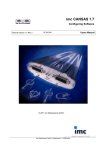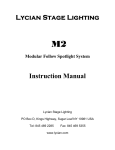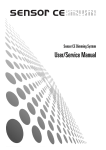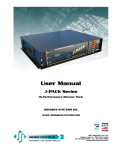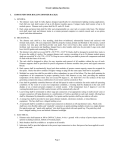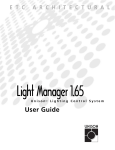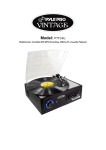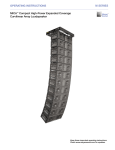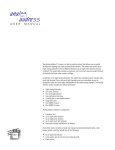Download Sensor Touring Rack User Manual
Transcript
sE nsor Touring Rack USER MANUAL Contents Traveling panels ......................................... 3 Doors .......................................................... 3 Beacon ....................................................... 3 CEM ........................................................... 4 Removing the CEM .............................. 4 CEM swapping ..................................... 4 Dimmer modules ....................................... 5 Circuit breakers .................................... 5 Removing dimmer modules ................. 5 LEDs ..................................................... 5 Bump buttons ....................................... 5 Patch panel ................................................. 6 Feed, output and data connections ............ 6 Data ports ............................................. 6 Power distribution panel ....................... 7 Fuses .................................................... 7 Test points............................................ 7 Indicators .............................................. 7 Hot pockets .......................................... 7 Convenience outlets ............................. 7 Write-on strips ...................................... 7 Cooling fan ................................................. 8 Air filter ....................................................... 8 Ambient temperature ................................. 8 Electronic Theatre Controls, Inc. UL and C UL Listed AC Lighting Loads Only For Indoor Use Only Utilizer Dans Un Endroit A L'Abri ETC Sensor dimming equipment is protected by US patent number 5,352,958. 7053M1001 3030 Laura Lane, Middleton, WI 53562 800/688-4116 FAX 608/836-1736 Copyright 1994-95 Electronic Theatre Controls, Inc. Specifications subject to change. Revised 1-95 2 Sensor Touring Rack User Manual sE nsor Touring Rack USER MANUAL ➋ ➊ ➍ ➌ Dimmer Outputs The Sensor Touring Rack is a modular dimming system that consists of a Control Electronics Module (CEM) and fan-cooled dimmer modules housed in a steel frame with ABS plastic exterior paneling. Note: The illustrations in this manual represent a typical rack. Many racks are custom-built to customer specifications and so may not match the illustrations. ➎ ➐ ➏ Hot Pockets ➑ ➒ Traveling panels The Sensor Touring Rack is protected during travel by front and back traveling panels. These must be removed when the rack is being used. The rack will not function while they are installed. To remove the panels, follow these steps: 1. Insert a finger into each latch hole along the top edge of the front or back of the rack. 2. Press latch bolt until it is fully retracted. It will click and stay in retracted position. 3. Grasp the panel by the two handles. Lift panel until bottom edge is free of the lip. Caution: The panel is heavy. Do not drop it on your feet. 1. Control Electronics Module (CEM) 2. Latch hole 3. Patch bay - light switch 4. Patch bay - outputs 5. Dimmer modules 6. Beacon 7. Patch cables 8. Patch bay - hot pockets 9. Spare dimmer modules 4. Pull bottom edge out slightly, then lower panel until it is free of the rack. To replace the panels, set the top edge, then lower the bottom edge into place. Press the latch bolts to lock panel into place. Doors Each Sensor rack is equipped with a full-height door that contains an electrostatic air filter to protect each column of dimmer modules. To ensure proper cooling, the doors must be kept closed except when you are working on the rack. The patch panel has a solid door with no filter. This door may be left open while operating. Beacon An LED status beacon is mounted between the dimmer and patch panel doors. Under normal operating conditions, this beacon is illuminated. If the rack’s CEM senses a problem with the rack, the beacon flashes until the problem has been corrected. If the beacon is flashing or off, check the CEM’s display for error messages. See the CEM User Manual for more information or call ETC Technical Services at 800/775-4382. CEM The Sensor Control Electronics Module (CEM) is the primary user interface for the Sensor dimming system. It includes a keypad for user input, and an LCD screen for information display. The CEM is located in the top slot of the touring rack. The SP48 rack also provides a slot for a spare CEM. For detailed information about the CEM, see the CEM User Manual. sE nsor Dimmer 7 8 9 Exit OA About 4 5 6 Next OB Backup 1 2 3 Thru OC Setup A/B 0 At Clear Enter ETCLink Reset Handle Removing the CEM In certain situations, you may need to remove the CEM. You do not need to disconnect power to the rack prior to doing so. To remove the CEM, slide the retractable handle out of the bottom edge of the front panel, grasp it firmly, and pull the module out. Replace the handle. To reinstall the module, align it correctly and press it firmly into place by the sides. Warning: The CEM contains exposed electrical components. Do not touch any of the CEM’s internal components while removing the module. Do not touch the bottom of the CEM until the module is completely removed. Two holes in the CEM’s bottom panel expose live AC power. Use only the handle to pull out the CEM. CEM swapping In multiple rack Sensor systems, each CEM contains complete system configuration information for the entire system. This allows you to swap CEMs in the unlikely event that a CEM should fail. Once you swap CEMs, use the new CEM to re-enter the ETCLink address of the current rack. The CEM will then load the appropriate settings and tables for that rack. For instructions on setting the ETCLink address, see Setting ETCLink address in the CEM User Manual. If your rack includes a spare CEM, you may load the settings for the rack into both modules. This allows you to swap CEMs without needing to do any additional programming. For more information, see Replacing a CEM in the CEM User Manual. 4 Sensor Touring Rack User Manual Dimmer modules OFF OFF Each Sensor rack contains one active CEM. The SP48 also provides space for a spare. Each rack also contains 12, 24, 36, or 48 dimmer modules. (If doubleheight modules are used, racks may be configured with fewer dimmer modules.) Sensor racks support 15A, 20A, 50A, or 100A dimmer modules in various combinations. Racks with patch bays provide slots for three spare dimmer modules. ➊ ➋ Signal 20 A Signal 20 A Standard Sensor 20A dimmer module 1. Circuit breakers On the left end of a dimmer module’s front panel are either one or two circuit breakers. If the breaker switch is to the right, the circuit is off or tripped. If the breaker switch is to the left, the circuit is on. In the event of a short circuit, the circuit breaker trips automatically and the dimmer shuts off. Once the problem causing the short circuit has been resolved, turn the circuit breaker back on, and the dimmer will resume operation. Removing dimmer modules In certain situations, you may need to remove a dimmer module. Dimmer modules are held in by the module retainer that extends over the left edge of the modules. To remove the module, follow these steps: Warning: Be careful not to trap your fingers between the module and the rack when inserting or removing modules. 1. Turn circuit breakers off on the module to be removed. 2. Press module retainer in. Retainer is spring-loaded and retracts easily. 3. Grasp the metal handle that extends from the face panel. 4. Gently pull the dimmer module out. To replace the module, push back the retainer and insert the module firmly until you feel it seat securely. When the module is correctly seated, it should be flush with the other dimmers in the rack. Warning: When modules are removed, do not touch the exposed copper bars. If more than one adjacent modules are removed, the high voltage copper bars are easy to reach. 2. LEDs All modules have an LED marked Signal which is on whenever the dimmer is on. Sensor AF (Advanced Features) modules also have an LED marked Output which is on whenever the dimmer’s output is above zero. If the module contains two dimmers, it will have two sets of LEDs, one for each dimmer. Bump buttons Your rack may be equipped with optional bump buttons. The bump buttons run down the strip to the right of the door protecting the dimmer modules. Each dimmer has a corresponding bump button. Press the bump button to raise that dimmer’s outputs to full. Sensor Touring Rack User Manual 5 Dimmer Outputs 1 A B C D E F G H I J K L M N O P 2 3 4 5 6 7 8 9 10 11 12 13 14 15 16 17 18 19 20 21 22 23 24 25 26 27 28 29 30 31 32 33 34 35 36 37 38 39 40 41 42 43 44 45 46 47 48 Hot Pockets 1 2 3 4 Patch panel The optional patch panel allows you to patch dimmer modules to output circuits. Each multi-pin connector on the back of the rack leads to a cluster of cables by the patch panel. In a rack with 12-circuit multi-pin connectors, the cables are labeled A1 through A12, B1 through B12, and so forth. In a rack with 6-circuit multi-pin connectors, they are labeled A1 through A6, B1 through B6, and so forth. The patch panel contains connectors, labeled 1 through 48 or 1 through 96, corresponding to the dimmer modules. To connect an output circuit to a dimmer module, insert the appropriate cable connector into the appropriate dimmer connector. The panel provides either two or four outputs per patch point (two is standard). The patch panel also contains patch connectors for the rack’s hot pockets. Hot pockets connect outputs to the main power feed and are not dimmed. You may connect an output directly to a hot pocket on the back of the rack, or you may patch it to the hot pocket through the multi-pin connectors on the patch panel. Feed, output and data connections The back side of the Sensor Touring Rack contains the stage pin and/or multi-pin connector panels, the data ports and the power distribution panel. Cables to your lights or other output devices are plugged into the connector panels. White write-on strips beneath each row of connectors allow you to label the connectors using a grease pencil. The power distribution panel contains the main circuit breaker, Cam-Lok power input connectors, hot pockets, and convenience outlets. Note: Three types of connector panel (Pyle National, Socapex or Veam) are available for the Sensor Touring Rack. You may exchange connector panels as necessary. Contact ETC Technical Services for information on ordering and installation. Data ports The control panel contains connectors for DMX512 A, DMX512 B and ETCLink input and pass-through. Each port also has a terminator button. If this rack is the last rack in the system, you must enable the terminators. To enable the terminator, press the terminator button. When the button shows a green indicator, the terminator is enabled. DMX A 6 DMX B ETCLink Sensor Touring Rack User Manual Power distribution panel Attach the Cam-Lok power connectors in the following order: 1. Grounding connector (Green) 2. Neutral connector (White) 3. Phase connectors (Red/Blue/Black) Disconnect connectors in reverse order. Warning: Multiple power leads may be attached to this rack. Disconnect all power leads before servicing or attempting to work on any part of this device. Cam-Lok power connectors must be installed and removed by qualified personnel only. Convenience outlets Main circuit breaker ➎ Hot pockets MAIN ➏ 400A. ➍ ØA ØB ØC NEU GND Cam-Lok inputs ➊ ➋ 1. Fuses ➌ One 2AG fuse is located above each phase connector. The fuse protects that phase’s indicator and test point. 2. Test points One test point is located above each phase connector, the Neutral connector and the Ground connector. The test points allow you to take AC measurements. Phase connector detail 3. Indicators The indicator light located above each phase connector indicates whether that phase has power. 4. Hot pockets Hot pockets are power connectors connected directly to the main power feed. They are not controlled by dimmers. Output circuits may be connected directly to a hot pocket, or may be patched to it through the multipin connectors and the patch panel. 5. Convenience outlets Four 120 VAC convenience outlets are provided. 6. Write-on strips Use a grease pencil to make notes on the write-on strips by the convenience outlets and hot pockets. Use a clean, dry cloth or paper towel to clean them. Sensor Touring Rack User Manual 7 Cooling fan Each column of dimmer modules is cooled by a fan located at the bottom of the rack. The fan(s) runs when any dimmer in the rack is receiving DMX512 control signal over zero. They continue to run for five minutes after all dimmers are off. Air filter Each Sensor rack is equipped with an electrostatic air filter mounted in each rack door. The rack’s cooling fan draws air through the filter, over the surfaces of the modules and then blows it out the bottom of the rack. The air filter removes dust and other airborne debris from the cooling air. Cleaning the filter To ensure proper cooling, the filter(s) should be cleaned every six months (more often in dirty locations). With proper care and regular cleaning, the filter should last as long as your Sensor rack. To clean air filter, follow these steps: 1. Open the door. 2. Brush or vacuum filter from both sides. 3. If a more thorough cleaning is necessary, use compressed air to blow out embedded dust and dirt. To remove air filter (for replacement or more thorough cleaning) follow these steps. 1. Open the door. 2. Use a Phillips-head screwdriver to remove the metal strip holding down the left side of the filter. 3. Remove filter from door. 4. Reverse procedure to replace filter. Ambient temperature The average temperature in the space where the rack is located should be about 68°F (20°C). Under no circumstances should the temperature exceed 104°F (40°C). Note: The ambient temperature displayed by the CEM is only shown when the fan is running. Use a thermostat or other external thermometer to determine current room temperature Warning: Never place objects that may block air flow beneath or in front of your rack. 8 Sensor Touring Rack User Manual








